Far from the niche sport on display in adventure magazines and TV specials, ice climbing is one of the fundamental skills of alpinism. A full quiver of skills will enable a climber to cross heavily crevassed glaciers, pass bergschrunds, and link up small flows with pitches of rock-climbing in pursuit of a summit. Keep reading to learn more about alpine ice, waterfall ice, and the different challenges they present to alpinists.
Ice Climbing Courses
Skills Instruction for Climbing Alpine and Waterfall Ice
The sport of ice climbing can be broken into two sub-disciplines: alpine ice and waterfall ice.
Alpine ice forms from compacted snow. It persists through the summer in high snowfields and gullies, and on glaciers. Glaciologists sometimes refer to alpine ice as "bubbly ice" because it contains tiny air bubbles left over from the compaction process. Snow that accumulates in snowfields and couloirs in the alpine zone will consolidate and harden over the course of the summer season, forming a firm surface that mountaineers call firn (from German) or névé (from French). The process of consolidation continues in subsequent seasons; it takes about three years for snow to transform into true alpine ice. Both glaciers and the perennial "snowfields" found in the high alpine zone have cores composed of alpine ice.
Mountaineers seek out alpine ice routes year-round, but especially in the summer season, when cool nights and warm days produce enjoyable climbing conditions and the ice itself is generally plastic, providing easy, solid tool placements and allowing rapid movement past obstacles.
Waterfall ice, on the other hand, freezes directly from dripping or running water. It normally forms at lower elevations only in the winter season, when air temperatures are consistently below freezing. "Water ice" can exhibit a very wide range of conditions. In very cold weather, it can be highly brittle, shattering into "dinnerplates" that spall off when struck with an ice tool. In wet conditions, hollow spaces behind the ice can impound meltwater that bursts out unpredictably. These challenges make water-ice climbing an exciting mental, as well as physical, sport.
Water ice climbing skills are useful not only in winter on waterfalls and icicles at lower elevations, but also on summer alpine routes where the daily freeze-thaw cycle produces flows of meltwater ice. Routes that follow gullies or that access high snowfields may require stretches of water-ice climbing, even in mild conditions.
In addition to these two main forms of ice, there are a few others that figure mainly in more advanced climbing.
Rime ice forms directly from moist, supercooled cloud or mist, usually on the windward side of rocks. Rime ice plays an important part in ice climbing in cold, maritime climates like Patagonia and Scotland.
Verglas, or black ice, is a thin layer of water ice that coats rock after rain or during a melt-freeze cycle; it can turn an ordinary rock climb into a difficult alpine route. Thin smears of verglas sometimes force the use of special techniques to link up otherwise straighforward flows.
Lastly, sometimes the ice runs out, leaving an ice-climber with bare or snow-dusted rock for short stretches. Dry-tooling is the use of ice tools on bare rock. Picks can be cammed into cracks and crampon points can be used to gain purchase on narrow edges.
A seasoned alpinist will frequently encounter many kinds of ice on climbing trips, and needs the skills to cope with all of them.
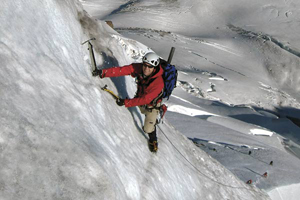 High on the North Ridge of Mt. Baker. Alasdair Turner
High on the North Ridge of Mt. Baker. Alasdair TurnerThe first course offered by AAI in 1975, this intensive program provides thorough instruction in all the skills required on difficult alpine ice climbs. Through this curriculum, you will develop a complete repertoire of state-of-the-art high-angle snow and ice climbing skills and learn to apply them efficiently in all conditions. All of this instruction is located in America's top glacier training area, the Coleman Glacier of Mt. Baker.
- Location:North Cascades, WA
- Season:May - September
- Length:6 Days
- Cost:$1995
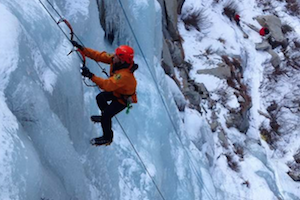 A climber follows a pitch on Chouinard Falls, Lee Vining Canyon, CA. Ian McEleney
A climber follows a pitch on Chouinard Falls, Lee Vining Canyon, CA. Ian McEleneyThe introductory course will teach new ice climbers the basics of ice climbing, crampons, ice tools, ice screws, belaying, knots and top-rope climbing techniques - all the basics required to be a competent top-roping ice climbing partner. The intermediate course will cover ice climbing techniques on steeper ground and gain the skills to follow and lead ice climbs in a multi-pitch setting.
- Location:Washington, Colorado, and California
- Season:January - March
- Length:2-day Intro Course / 5-day Intermediate Course
- Cost:$650 for Intro Course / $1495 for Intermediate Course
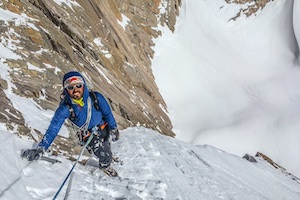 A climber on the Broadway Ledge of Longs Peak in the winter. Picture by Zach Lovell
A climber on the Broadway Ledge of Longs Peak in the winter. Picture by Zach LovellThis skills-focused course is designed to help mountaineers and experienced backpackers transition to alpine travel and climbing in winter conditions. Held in Colorado’s glacier-carved Rocky Mountain National Park, this course gives students the opportunity to enjoy some great winter climbing opportunities in an accessible venue, just 70 miles from Denver International Airport.
- Location:Rocky Mountain National Park, Colorado
- Season:January – March
- Length:5-day Winter Mountaineering / Private Varies
- Cost:$1895 for Winter Mountaineering / $595 for Private 1:1
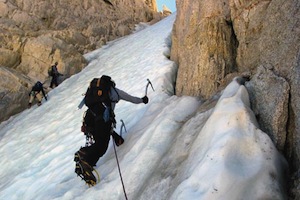 Rope teams using two-tool technique as they near the exit of the V-Notch Couloir. Michael Powers
Rope teams using two-tool technique as they near the exit of the V-Notch Couloir. Michael PowersAlpine ice persists year-round in many shaded couloirs and gullies in the high Sierra. This terrain is the perfect outdoor classrooms for teaching alpine ice climbing, one of the fundamental skills of mountaineering.
This course will prepare you for any alpine ice you would encounter in the Sierras and give you a solid base for climbing on larger glaciers in the Pacific Northwest and beyond.
- Location:Eastern Sierra Nevada, California
- Season:Currently unavailable
- Length:6 Days
- Cost:Contact AAI Office for more details
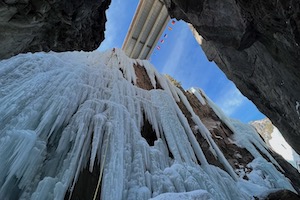 Some stunning ice climbing in the Ouray Ice Park, CO. Suzanna Lourie
Some stunning ice climbing in the Ouray Ice Park, CO. Suzanna LourieWith immediate proximity to town and hundreds of routes to learn and train on, there is no better place to learn or explore ice climbing than the Ouray Ice Park and the San Juan backcountry of the Rocky Mountains.
- Location:Ouray, Colorado
- Season:December through April
- Length:One day and up
- Cost:$525/day for 1:1; lower rates for larger parties
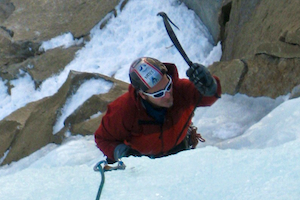 Climbing perfect ice in Lee Vining Canyon. Ian McEleney
Climbing perfect ice in Lee Vining Canyon. Ian McEleneyAccessible from Sacramento, Reno, Lake Tahoe and Las Vegas, Lee Vining Canyon and the June Lake area in the Eastern Sierra provides some of the finest steep water ice climbing in North America. The Canyon is an excellent place to learn to climb, advance your skills, push into multi-pitch terrain, or combine all of these things into one highly educational, customized course.
- Location:Lee Vining Canyon, Eastern Sierra, CA
- Season:December - Early March
- Length:1 day and up
- Cost:Varies with program
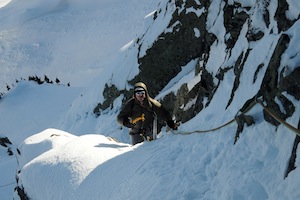 A climber enjoying mixed terrain on Chair Peak, WA. Alasdair Turner
A climber enjoying mixed terrain on Chair Peak, WA. Alasdair TurnerWashington is home to a great variety of ice climbing opportunities. Learn the basics of ice climbing in one of our introductory courses or, once you have the skills, join us for a guided winter ascent of an alpine route.
- Location:North Cascades and Central Washington
- Season:December - March
- Length:1 day and up
- Cost:Varies